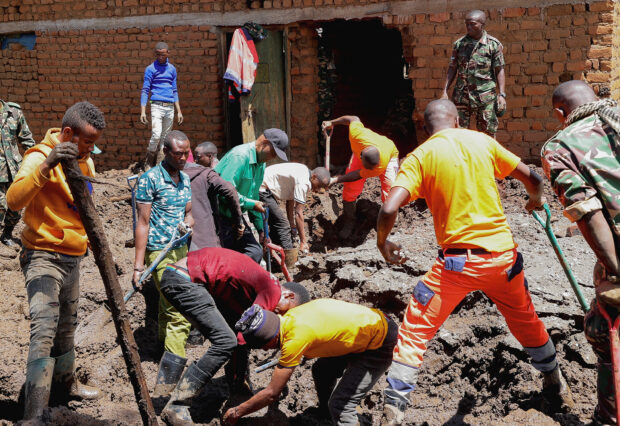
Members of the Tanzania Defense Forces and rescuers search for the bodies of people killed following flash floods and landslides near the slopes of Mount Hanang in the Manyara region, Tanzania, December 4, 2023. REUTERS/Stringer
DAR ES SALAAM — The death toll from floods in northern Tanzania following torrential rains this weekend has risen to 63, the prime minister said Monday, adding to hundreds of other deaths caused by extreme weather in East Africa since seasonal rains began in October.
Prime Minister Kassim Majaliwa said in comments broadcast on television that the number of injured stood at 116 people. Landslides had destroyed half of one village he visited, he said.
“We are here in front of bodies of our fellows. We have lost 63 loved ones. Of the total fellows we lost, 23 are men and 40 are women,” he said during an event to bid farewell to the bodies of those who had died in Hanang district, northern Tanzania.
“My fellow Tanzanians, this is a tragedy,” he said.
READ: Kenya raises alarm as flooding death toll rises to 76
Earlier on Monday, President Samia Suluhu Hassan had put the number of dead at 57 and those injured and receiving treatment at 85.
Zuhura Yunus, a spokesperson for her office, said the floods and landslides had affected 1,150 households, or 5,600 people, with 750 acres of farmland destroyed.
Severe flooding caused by the El Niño and Indian Ocean Dipole weather phenomena has forced hundreds of thousands from their homes in Kenya, Somalia, Ethiopia, and Tanzania since the rains began.
The flooding comes on the back of the worst drought to hit the region in 40 years. Dry soils are less able to absorb water, increasing the risk of flash-flooding.
READ: Death toll from flooding in Somalia climbs to nearly 100
Yunus said Hassan would shorten her trip to the COP28 climate talks in the United Arab Emirates to oversee the response to the incident.
“Despite all the challenges rescue work is facing from damaged roads and mud and logs filling the roads, the government is doing its best to deal with that,” Yunus said.
Queen Sendiga, commissioner of the Northern Manyara region, told reporters late on Sunday that authorities were still searching for bodies trapped in the mud.
Around 100 houses in the village of Katesh, Hanang district, were swallowed by a landslide, Sendiga said, adding that they did not know the whereabouts of people from 28 households.
READ: Once-in-a-century flooding swamps Somalia after historic drought — UN
Television footage showed streets turned into fast-flowing rivers of mud carrying debris past flooded houses.
Climate change is causing more intense and more frequent extreme weather events, according to climate scientists.
In response, African leaders are pushing for new global taxes and changes to international financial institutions to help fund climate change action.
In neighboring Kenya, where floods have so far killed at least 154 people, the banks of the Voi River in the country’s south burst on Monday, the Kenya Red Cross said.